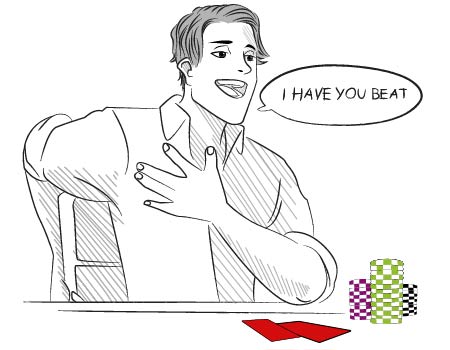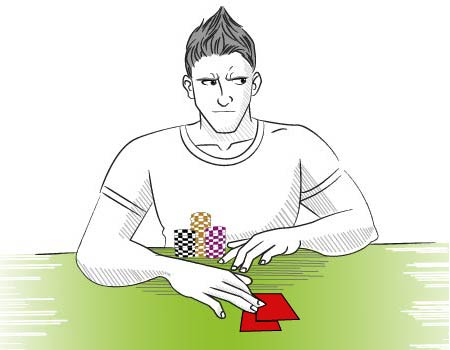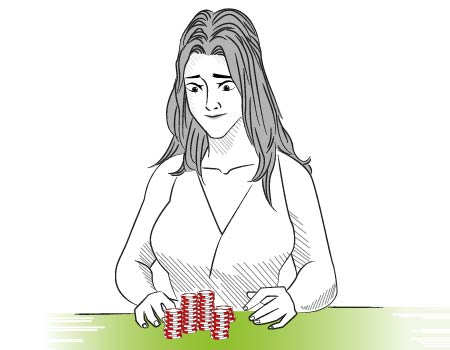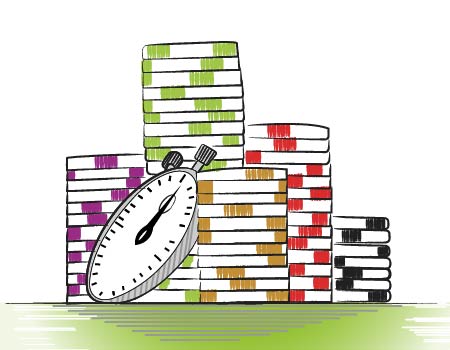HOW TO SPOT A POKER BLUFF
To make the best possible decisions, poker players must notice and assess all information available to them, which includes picking up on tells from their opponents.
Such tells can be verbal or physical (i.e. body movements or positions that reveal the strength of one’s hand), or relating to the hand itself (i.e. bet sizing and timing tells).
Table of Contents
BASIC TELL RECOGNITION
 In general, especially for the physical tells, there are a few underlying concepts to understand that will help tip you off as to whether your opponent has a strong hand or could potentially be bluffing:
In general, especially for the physical tells, there are a few underlying concepts to understand that will help tip you off as to whether your opponent has a strong hand or could potentially be bluffing:
|
- Tense or Relaxed: Another common tell that will apply for body language will be in recognising whether their body position is still or relaxed. If someone appears genuinely at ease (i.e. deep breaths, swinging feet, swivelling in chair, casual movements), then they are likely comfortable with their hand and are value betting. Oppositely, due to the nervousness that comes with bluffing, humans will often default to the fight, flight, or freeze response (and in poker, this will translate to a “freeze”). If you notice tension in a frozen position from your opponent after they bet, it’s quite possible that they could be bluffing.
While relying on tells should help enhance your decision-making, it should not be used as the primary decision point to go by when deciding to call, fold, or raise; instead, it should be used to supplement the information you’ve already gained from the hand itself.
Furthermore, do not become too reliant on any one tell once you notice it. It’s possible it happened by chance the first time and isn’t guaranteed to happen again.
That said, here’s a comprehensive list of tells that can help you figure out if someone might potentially be bluffing in poker.
PHYSICAL TELLS (LIVE)

- Eye Movements: Ever wondered the real reason some players wear sunglasses at the table? It’s because your eyes can truly be extremely revealing as to the strength of your hand (as the next 5 tells will illustrate). Depending upon where someone’s gaze is situated or where their eyes commonly shift to, you can start to gain some information on which parts of the brain are being used and accessed when they are thinking. For example, a common model dictates that if someone looks either left or up and to the left, it means that the individual is drawing upon fabricated, made up information from a visual or auditory standpoint. (In other words, they may be bluffing.)
- Where They Look after Cards are Dealt: If your opponent keeps staring at the board after the community cards, it’s likely they didn’t help his hand. Alternatively, if he looks away almost instantly (trying to subconsciously appear disinterested), he’s likely to have connected well.
- Looking at Chip Stack: Seeing someone look at his chip stack is an involuntary reaction caused from wanting to bet immediately when they make a strong poker hand. Looking at another’s chipstack before betting can also be a sign of strength, as they’re going into “predator” mode in thinking how they can win all their opponent’s chips.

- Hard Swallow: If you see someone swallow hard after betting, it is usually an indication of nervousness, quite possibly indicating a bluff.
- Shaking Hands: Caution! Shaking hands when betting usually doesn’t mean the person is nervous from trying to bluff; instead, this is most commonly the release of tension that someone experiences when they genuinely have a big hand. Don’t be fooled by this one!
- Feet Movements: After betting, if someone’s feet are relaxed and have movement, this likely indicates that they are comfortable with their hand. If their feet are stiff or frozen, it might indicate a bluff.
- Tense Shoulders: Like the feet tell above, if you notice tension in someone’s shoulders after betting, it might mean a bluff.
- Eliminating Stress: When someone bluffs, it’s usually a stressful situation for the bluffer. If you see them rubbing their hand over their mouth or massaging their neck after betting, this is usually done because of genuine tension of a stressful situation.
- Heavier/Shallower Breathing: As aforementioned, when someone lies, stress is created. This stress causes the body to require more oxygen to function, which will result in heavier and/or faster breathing.
- Confidence: Don’t confuse confident body positions with the “intimidation factor” mentioned in the point on “Eye Gaze” above. Someone who is relaxed and confident (i.e. with steepled fingers) likely has a big hand. If they’re seated in an unconfident position, (i.e. with interlocked fingers), they might just be bluffing!
- How They Bet: If your opponent slides his bet out into the middle of the pot, keeping his stack tidy, he likely has a good hand. If your opponent places out his bet forcefully and in an uncaring fashion, he’s trying to display overconfidence and instil intimidation in others, likely because he’s bluffing. Similarly, the chip denomination he uses when betting or how he arranges his bet might give off clues as to the strength of his hand.
BETTING TELLS (ONLINE/LIVE)

|
|
While we’ve now covered some things to look for to catch a bluff, in the next section, we’re going to put you in the driver’s seat and start to reveal steps for how you can become the ultimate bluff catcher by calling that bluff!
